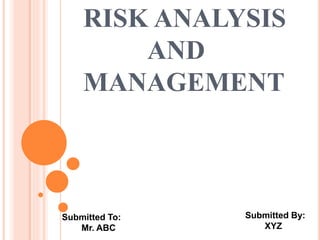
Risk Analysis and Management
- 1. RISK ANALYSIS AND MANAGEMENT Submitted By: XYZ Submitted To: Mr. ABC
- 2. CONTENT Introduction Process of Risk Management Risk Identification Internal Risks External Risks Risk Assessment Risk Response Planning and Control
- 3. INTRODUCTION Risk is a function of the chance and the result of an undesired event happening. Risk can also be said to be the failure of not meeting the schedule/ budget/ technical parameters. Risk cannot be eliminated, only reduced.
- 4. PROCESS OF RISK MANAGEMENT Risk Identification Risk Assessment Risk Response Planning Risk Response Control
- 6. RISK IDENTIFICATION SOURCES OF RISK Any factor which can influence the end result of project is a Risk factor or Risk hazard. Risk classified as- internal and external
- 7. INTERNAL RISKS Originates inside the project Project managers & the organization generally have a degree of control over them. Market risk and Technical risk Market risk- Incomplete identification of customer needs - Failure to identify changing needs - Failure to identify new products
- 8. Technical Risk is not meeting the cost, time and performance requirements due to technical problems with the end items of project. Technical risk is high in new technologies, new skills, new products Technical risk is low in projects dealing with familiar activities
- 9. EXTERNAL RISKS Market Conditions Competitor’s action Government Regulations Interest Rates Customer Needs and Behavior Supplier relations Weather Labor and material availability
- 10. RISK ASSESSMENT Only the important ones need to be assessed. Risk chance is -- the probability of happening- low/ medium/ high -- assign numerical values - 0 to 1.0 Risk impact (result) -- specified in terms of time, cost and performance measures-- assign numerical values. The expected value of risk is calculated as- (result) x (chance) = probability of happening
- 11. RISK RESPONSE PLANNING AND CONTROL Methods of dealing with risk- Transferring risk Altering plans or procedures to avoid or reduce risk Prepare contingency plans Accepting the risk
- 12. Transfer the Risk Paying a premium to pass the risk to another party. Warranties, penalties, contractual incentives attached to project cost, schedule or performance measures. Different types of contract share it in different ways Fixed cost contract- with contractor Fixed price with incentive fee- contractor accepts about 60% Cost + incentive- contractor accepts about 40% Cost + fixed fee- with the customer
- 13. Avoid Risk Changing the project plan to eliminate the risk or condition. By altering the original project concept Eliminating the risky elements Minimizing system complexity Reducing end-item quality requirement Changing contractor Safety procedures Avoiding reduces payoff opportunities New product design
- 14. Reduce Risk Reducing the chance that an adverse event will occur Reducing the impact of adverse event. Reducing Technical Risk- Employ the best technical team Base decisions on models and simulation of key technical parameters Use computer aided system engineering tools Perform test and evaluations Minimize system complexity
- 15. Reducing Schedule Risk- Create a master project schedule and adhere to it Maintain focus on critical activities Allot best workers on time-critical activities Schedule risky tasks as early as possible to allow time for failure from recovery Reducing Cost Target Risk- Identify and monitor the key cost drivers Use low-cost design alternative reviews and assessments Use proven technology Perform prototyping and testing on risky components and modules
- 16. CONTIGENCY PLANNING Identify the risk, anticipate whatever might happen, and prepare a detailed plan of action to cope with it. Initial project is followed, and monitored closely throughout execution. A remedial measure to compensate for impact An action taken in parallel to original plan
- 17. ACCEPT RISK Do nothing! Cannot be used as an option when the impact is likely to severe.
- 18. THANK YOU
